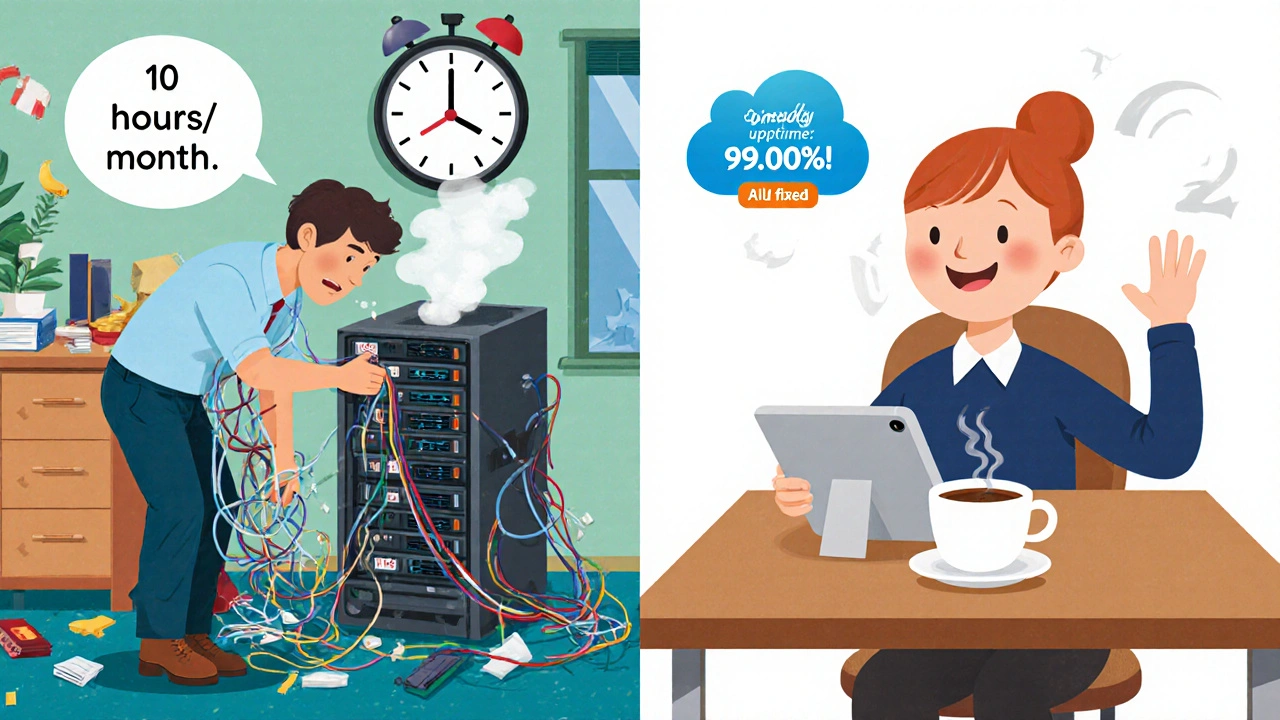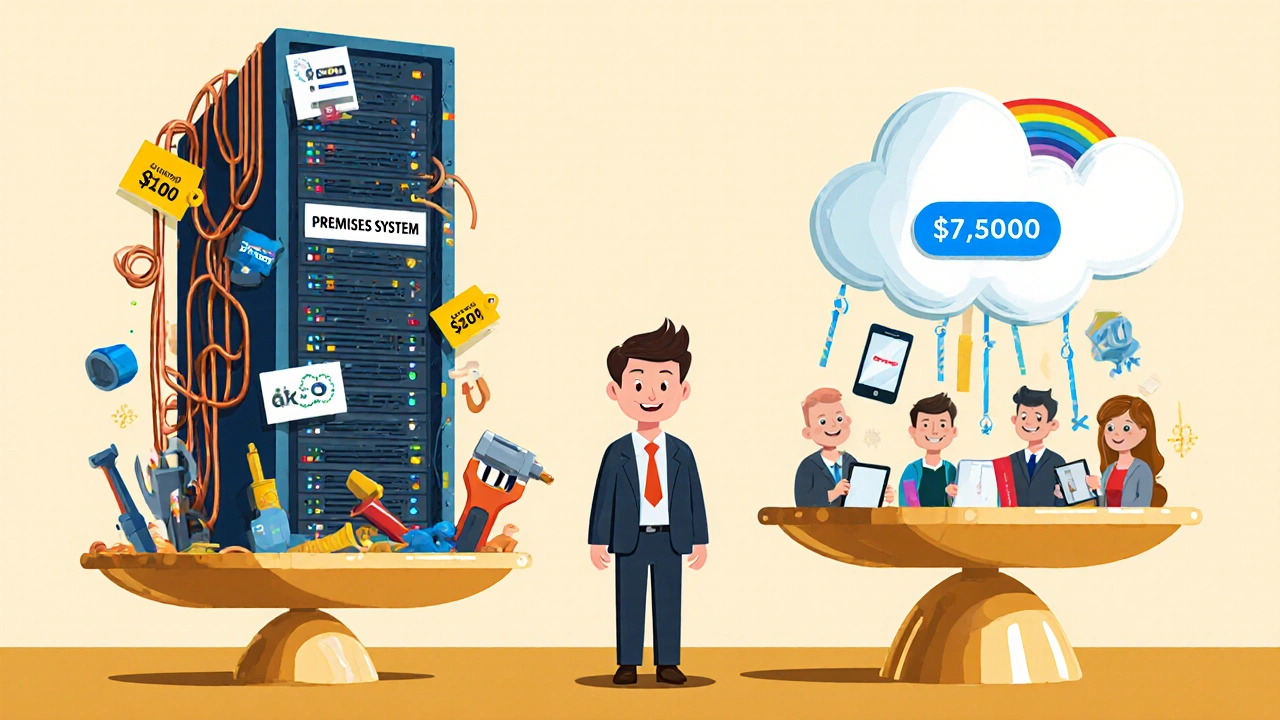When you’re choosing a phone system for your business, you’re not just buying hardware or software-you’re signing up for a five-year financial commitment. Most companies focus on the upfront price tag: how much does the system cost to install? But that’s like judging a car only by its sticker price and ignoring fuel, insurance, and repairs. The real story is in the Total Cost of Ownership-everything you’ll spend over time to keep your phone system running, growing, and reliable.
For years, businesses relied on premises-based systems: big boxes of hardware in a server room, copper lines wired to every desk, technicians crawling under desks to fix a broken phone. Today, cloud VoIP systems run over the internet, with no physical server needed. The shift isn’t just about convenience-it’s about money. And the numbers don’t lie.
Upfront Costs: The Hidden Trap of Premises Systems
Let’s start with what you pay on day one. A premises-based system-whether it’s an old-school PBX or a modern on-premises VoIP setup-requires serious capital. You need servers, switches, power backups, and enough physical space to house them. For a 10-person office, expect to spend $2,000 to $10,000 just to get the system installed. Add in cabling, phone handsets ($100-$400 each), and configuration labor, and you’re easily over $15,000 before anyone even makes a call.
Cloud VoIP? You pay nothing upfront-or maybe $500 for a few IP phones if you don’t want to use your laptop or smartphone. That’s it. No server room. No electrician. No IT team spending weeks wiring everything. The provider handles the infrastructure. Your only upfront cost is time: maybe a day or two to set up accounts and train staff.
Here’s the kicker: premises systems aren’t just expensive to install-they’re expensive to upgrade. Need to add five new users? You might need a new circuit board, extra licenses, and a technician to reconfigure the whole system. With cloud VoIP, you click a button. That’s it.
Monthly Costs: Predictable vs. Surprise Bills
Monthly fees tell the real story. Cloud VoIP plans typically run $15-$40 per user per month. That includes unlimited calling, voicemail, auto-attendant, mobile apps, and even advanced features like call recording and CRM integration. Some providers bundle AI transcription or analytics right in-no extra charge.
Premises systems? You’re looking at $40-$80 per user per month, and that’s just the tip of the iceberg. That fee often covers only the software licenses. You still pay for: maintenance contracts ($100-$500/month), server power and cooling, hardware repairs, firmware updates, and IT staff time. One small business owner in Exeter told me his $60/user/month VoIP license turned into $110 when he added up the hidden IT hours and hardware replacements.
And don’t forget international calls. On a traditional system, calling London from Manchester might cost $1.50 per minute. With cloud VoIP? It’s $0.01-$0.07 per minute. For a sales team making 200 international calls a month? That’s $300 saved every month-$3,600 a year.
Hardware and Equipment: Who Owns the Risk?
Premises systems force you to own and maintain every piece of hardware. Phones wear out. Servers fail. Power surges fry circuits. You’re responsible for replacements, backups, and compatibility updates. A single failed server can take down your entire phone system for hours-sometimes days if you’re waiting for parts.
Cloud VoIP shifts that risk to the provider. Your phones? They’re just endpoints. If one breaks, you swap it out. If your network goes down, the system reroutes calls to mobiles automatically. Most providers guarantee 99.99% uptime-better than most banks. And if a new feature drops-like AI call summaries or real-time translation-you get it overnight, no hardware upgrade needed.
Let’s say you buy 10 IP phones at $120 each for your premises system. That’s $1,200. Five years later, those phones are obsolete. You can’t use them with a new system. You’ve spent $1,200 on a $0 asset. With cloud VoIP, you use your existing devices-phones, tablets, laptops. Or you buy a new phone for $80 when you’re ready. No lock-in.

Scalability: Growing Without the Grit
Businesses grow. Sometimes fast. A startup hits 50 employees in 18 months. A retail chain opens three new locations. Premises systems aren’t built for that.
Adding a new user to a traditional PBX? You need to order hardware, schedule a technician, run new cables, reprogram the system, and test everything. It takes weeks. And if you need to scale back? You’re stuck with unused equipment.
Cloud VoIP? Add a user in five minutes. Remove one the same way. Seasonal hires? Temporary staff? Remote workers? No problem. You pay only for what you use. One business in Bristol added 12 temporary workers for the holiday season and didn’t spend a penny on new hardware. They just assigned softphones via the app. When the season ended, they turned off the accounts. Zero waste.
Support and Maintenance: Paying for Silence or Paying for Service
Premises systems require in-house IT expertise. You need someone who understands SIP trunks, VLANs, PBX configurations, and firmware patches. That’s not a junior admin-it’s a specialist. And specialists cost $50-$150 an hour. Even if you have an IT team, they’re not trained to fix your phone system. You’re paying them to do something they didn’t sign up for.
Cloud VoIP providers include 24/7 support in your monthly fee. No extra charge. No waiting for a call-back. If your call quality drops, you call the provider-they check the network, adjust QoS settings, and fix it. No internal ticket. No downtime. Some enterprise providers even offer proactive monitoring: they alert you before a problem happens.
One company in Leeds switched from an Avaya system to Zoom Phone. Their IT manager told me: "I used to spend 10 hours a month on phone issues. Now I spend zero. I get my time back. That’s worth more than the monthly savings."

Hidden Costs: What They Don’t Tell You
Cloud VoIP isn’t magic. There are traps.
First, internet quality matters. If your business has slow or unreliable Wi-Fi, VoIP calls will crackle or drop. You need at least 100 kbps per call. For 10 concurrent calls, that’s 1 Mbps. Most modern business connections handle this easily-but older networks might need an upgrade. Some providers offer free network assessments to help you avoid this.
Second, some vendors hide fees. Premium support? $20/user/month. Advanced analytics? $10/user/month. Call recording? Extra. Always read the fine print. The base price might look great, but add-ons can push you back toward premises-level costs.
Third, contract lock-ins. Some providers charge early termination fees-$500-$2,000-if you leave before your term ends. Read the contract. Look for month-to-month options. RingCentral and 8x8 offer them. Others don’t.
And finally, migration costs. Switching systems takes time. One Reddit user documented 200 hours of internal IT work to move 75 employees from an old Avaya system to Zoom Phone. That’s $5,000-$10,000 in labor if you pay your team. Factor that in. But even then, their five-year TCO dropped from $58,200 to $26,700. The upfront pain pays off.
Who Should Stick With Premises Systems?
Not everyone should switch. There are exceptions.
If you have a fully depreciated PBX system that’s still working fine, and you don’t need new features, staying put makes sense. The math doesn’t favor migration if your equipment is already paid for.
Same if you’re in a heavily regulated industry-healthcare, finance, defense-with strict data residency rules. Some organizations must keep voice data on-site for compliance. Cloud providers can meet these standards, but it adds complexity and cost.
And if your internet is unreliable-rural areas with poor broadband-premises systems might be more stable. But that’s changing fast. 5G and fiber are rolling out across the UK. By 2028, that excuse won’t hold up.
The Real Winner: Cloud VoIP
Over five years, a 10-user business spends roughly $3,000-$7,500 on cloud VoIP. On premises? $12,000-$30,000. That’s a 50-75% savings. For a 50-user company? The gap widens even more.
And it’s not just about money. Cloud VoIP gives you features premises systems can’t match: AI call summaries, mobile apps, remote work support, instant scaling, and automatic updates. You’re not just cutting costs-you’re upgrading your business.
The market agrees. In 2025, 68% of small businesses (1-50 employees) have moved to cloud VoIP. Mid-sized companies are catching up. Even enterprises, slow to change, are now adopting hybrid models-keeping legacy systems for a few departments while moving everyone else to the cloud.
The choice isn’t between old and new. It’s between paying more for less, or paying less for more. The data is clear. The technology is ready. The question isn’t whether to switch-it’s when.
Is cloud VoIP cheaper than premises-based systems over five years?
Yes, by a wide margin. For a 10-user business, cloud VoIP typically costs $3,000-$7,500 over five years. A premises-based system costs $12,000-$30,000. That’s 50-75% less. Savings come from eliminating upfront hardware costs, reducing monthly fees, cutting IT support needs, and lowering international call rates.
Do I need to buy new phones for cloud VoIP?
No, not necessarily. You can use softphones on your computer, tablet, or smartphone for free. If you prefer physical handsets, IP phones cost $50-$150 each-far less than the $100-$400 needed for premises systems. Many cloud providers let you reuse existing analog phones with an adapter.
What if my internet goes down?
Most cloud VoIP providers offer failover options. Calls can automatically route to mobile phones, landlines, or voicemail if your internet drops. Some systems even use cellular backup. It’s not perfect-but it’s far more resilient than a premises system that goes completely offline when the server fails.
Can I keep my existing phone number with cloud VoIP?
Yes. Federal regulations (FCC, effective January 2025) require providers to port numbers within 24 hours. Cloud VoIP providers handle this seamlessly. Premises systems often require manual coordination and can take weeks.
Are there any hidden costs with cloud VoIP?
Yes, if you don’t read the fine print. Some providers charge extra for premium support, advanced analytics, call recording, or international calling tiers. Always ask: "What’s included?" and "What costs extra?" Stick with transparent providers like RingCentral or 8x8 who bundle most features.
How long does it take to switch to cloud VoIP?
Most cloud VoIP systems deploy in 1-7 days. You can often start using the system the same day. Premises systems take 2-8 weeks due to hardware installation, cabling, and configuration. The faster rollout means less downtime and quicker ROI.
Is cloud VoIP secure?
Yes, enterprise-grade cloud VoIP providers use end-to-end encryption, multi-factor authentication, and regular security updates. Many meet compliance standards like HIPAA and GDPR. In fact, cloud providers often have better security than small businesses can afford on their own.
What happens if my cloud VoIP provider goes out of business?
It’s rare, but it happens. Since 2020, 12% of businesses have lost service when a small VoIP provider shut down. To avoid this, choose established vendors with strong financial backing-RingCentral, Zoom Phone, 8x8, or Microsoft Teams Phone. Avoid startups with no track record. Always check reviews and financial health before signing up.
